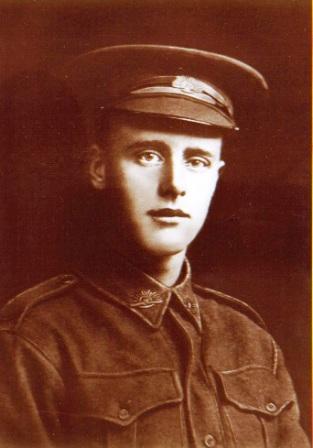Pte
George Richard Storey
Informations sur naissance
|
Année de naissance: 1894 |
|
Lieu de naissance: Stoke Newington, Hackney, Middlesex, Angleterre, Royaume-Uni |
Informations générales
|
Profession: Serviteur de la ferme |
Informations service militaire
|
Pays: Australia |
|
Force armée: Australian Imperial Force |
|
Rang: Private |
|
Numéro de service: 2488 |
|
Incorporation date: 31/03/1916 |
|
Incorporation nom de lieu: Perth, Western Australia, Australia |
|
Unités: — Australian Infantry, 51st Bn. (Dernière unité connue) |
Informations sur décès
|
Date de décès: 30/09/1917 |
|
Lieu de décès: Westhoek, Zonnebeke, Belgique |
|
Cause du décès: Killed in action (K.I.A.) |
|
Âge: 23 |
Cimetière
|
Buttes New British Cemetery, Polygon Wood Parcelle: I Rangée: E Tombe: 18 |
Distinctions et médailles 2
|
British War Medal Médaille |
|
Victory Medal Médaille |
Points d'intérêt 3
| #1 | Lieu de naissance | ||
| #2 | Lieu d'enrôlement | ||
| #3 | Lieu du décès (approximatif) |
Mon histoire
Private George Richard Storey served in the Australian Infantry 51st Battalion, part of the 13th Australian Brigade, of the 4th Australian Division.
The 51st Battalion participated on the 26th of September 1917 in the Battle of Polygon Wood, part of the Third Battle of Ypres. It occupied the Brickyard at the Southwestern outskirts of Zonnebeke. The Battalion was relieved on the night of the 27th by the Australian Infantry 46th Battalion, and moved back to Westhoek Ridge.
The 51st Battalion remained at Westhoek Ridge until 07.00 p.m. on September 1917 when it was relieved by the Australian Infantry 47th Battalion. During the march back, a shell exploded amongst “C” Company and killed Sergeant George Calder and Private George Storey and wounded two other men.
His remains were buried in a small cemetery in the hamlet of Westhoek. He was exhumed in 2006 and reburied at Buttes New British Cemetery , Polygon Wood in 2007. 2,108 men are buried or commemorated in this cemetery. Plot I, row E has 5 recent graves. Three of those are the remains of George Storey, John Hunter and George Calder. Together with their two fellow Australians, they were found in 2006 during earth works under a road in the nearby hamlet of Westhoek. Their bodies were covered with a ground sheet containing rubber, which made sure they were so well-preserved. During the war, some 30 dead were put together in a small cemetery close to the place the 5 were found. When the exhumation companies cleared the site after the war, most bodies were buried as ‘unidentified’ because their personal belongings had already been sent back to Australia and the crosses that once marked their graves were more than probably destroyed by subsequent fighting. The 5 Australians’ bodies were probably missed at the time, because the road through Westhoek had already been resurfaced. DNA was taken and in the end 3 bodies were identified thanks to intensive searching by the Australian authorities and the help of the Australian media.
The 51st Battalion participated on the 26th of September 1917 in the Battle of Polygon Wood, part of the Third Battle of Ypres. It occupied the Brickyard at the Southwestern outskirts of Zonnebeke. The Battalion was relieved on the night of the 27th by the Australian Infantry 46th Battalion, and moved back to Westhoek Ridge.
The 51st Battalion remained at Westhoek Ridge until 07.00 p.m. on September 1917 when it was relieved by the Australian Infantry 47th Battalion. During the march back, a shell exploded amongst “C” Company and killed Sergeant George Calder and Private George Storey and wounded two other men.
His remains were buried in a small cemetery in the hamlet of Westhoek. He was exhumed in 2006 and reburied at Buttes New British Cemetery , Polygon Wood in 2007. 2,108 men are buried or commemorated in this cemetery. Plot I, row E has 5 recent graves. Three of those are the remains of George Storey, John Hunter and George Calder. Together with their two fellow Australians, they were found in 2006 during earth works under a road in the nearby hamlet of Westhoek. Their bodies were covered with a ground sheet containing rubber, which made sure they were so well-preserved. During the war, some 30 dead were put together in a small cemetery close to the place the 5 were found. When the exhumation companies cleared the site after the war, most bodies were buried as ‘unidentified’ because their personal belongings had already been sent back to Australia and the crosses that once marked their graves were more than probably destroyed by subsequent fighting. The 5 Australians’ bodies were probably missed at the time, because the road through Westhoek had already been resurfaced. DNA was taken and in the end 3 bodies were identified thanks to intensive searching by the Australian authorities and the help of the Australian media.
Sources 5
|
51st Australian Infantry Battalion, (Australian War Memorial, Campbell (AWM), AWM4 23/68/19). https://www.awm.gov.au/collection/C1338583 Sources utilisées |
|
Australian War Memorial https://www.awm.gov.au/collection/P10263305 Sources utilisées |
|
Browning N., For King and Cobbers, (Bassendean, Advance Press, 2007), pg. 168-169. Sources utilisées |
|
Derycke K. en Ingelbrecht L., Memorial Museum Passchendaele 1917 visitor guide, (Gent, Openbaar Kunstbezit Vlaanderen, 2015), pg. 88. Sources utilisées |
|
First Australian Imperial Force Personnel Dossiers, 1914-1920, (National Archives of Australia, Canberra (NAA), B2455, STOREY G R). http://recordsearch.naa.gov.au/SearchNRetrieve/Interface/SearchScreens/BasicSearch.aspx Sources utilisées |
Complément d’informations 4
|
Commonwealth War Graves Commission Database https://www.cwgc.org/find-records/find-war-dead/casualty-details/1601384 |
|
The AIF Project (UNSW Canberra) https://aif.adfa.edu.au/showPerson?pid=290129 |
|
Namenlijst (In Flanders Fields Museum) https://namenlijst.org/publicsearch/#/person/_id=5b3f31da-7046-4953-a2b8-15d0c3cd96de |
|
Lives of the First World War (Imperial War Museum) https://livesofthefirstworldwar.iwm.org.uk/lifestory/7597167 |
